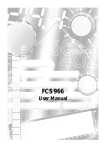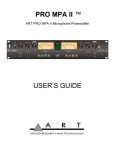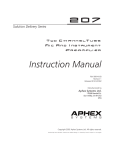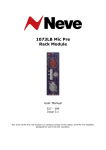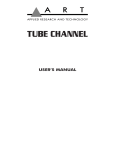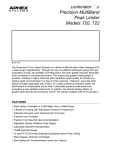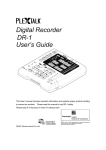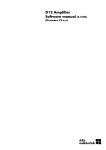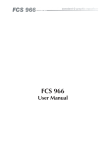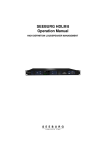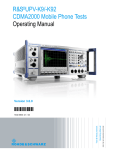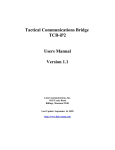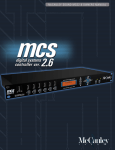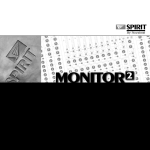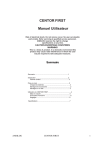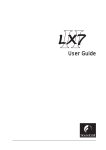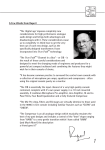Download User Guide - Soundcraft
Transcript
Introduction Safety Precautions Connections to Folio 4 The Controls at a glance - Mono Input Channel Stereo Input Channel Groups, Returns & Aux Masters Master Section Initial Setting Up Setting Up for Multitrack Recording The Controls in More Detail Stereo PA Applications Stereo PA with Centre Feed Stereo Recording 4-Track Recording Glossary Technical Specifications System Block Diagram 1 1 2 3 5 7 9 11 12 13 20 21 22 23 24 25 27 Introduction Thank you for buying a SPIRIT FOLIO 4 mixer, brought to you with pride by the SPIRIT team of Peter, Graham, Malcolm, Martin, Peter, Brian, George, Colin, Tony, James, Mukesh, Andy, Candy and Simon. We hope you have as much fun as we did! Owning a SPIRIT console brings you the expertise and support of one of the industry’s leading manufacturers and the results of over 20 years experience supporting some of the biggest names in the business. Built to the highest standards using quality components, FOLIO 4 has evolved from the acclaimed FOLIO mixer with the addition of 4 Audio Subgroups, 8 Auxiliary Sends, Stereo Effects Returns, Dual VU/PPM Metering and comprehensive monitoring. We have designed FOLIO 4 to be an instinctive and simple console to operate, but a few minutes spent reading this manual will help you to become familiar with the product away from the pressure of a live session, and allow you to gain full benefit from the superb performance which it offers. Above all, remember that your SPIRIT mixer is designed to extend your creativity. The more that you explore the controls and the effect they have on the sound output, the more you will appreciate how you can influence and enhance the final sound. SAFETY PRECAUTIONS For your own safety and to avoid invalidation of the warranty please read this section carefully. The FOLIO 4 desk must only be connected through the Power Supply Unit supplied. The wires in the mains lead are coloured in accordance with the following code: Green and Yellow: Earth Blue: Neutral Brown: Live As the colours of the wires in the mains lead may not correspond with the coloured markings identifying the terminals in your plug, proceed as follows: • The wire which is coloured Green and Yellow must be connected to the terminal in the plug which is marked with the letter E or by the earth symbol. • The wire which is coloured Blue must be connected to the terminal in the plug which is marked with the letter N or coloured Black. • The wire which is coloured Brown must be connected to the terminal in the plug which is marked with the letter L or coloured Red. Ensure that these colour codings are followed carefully in the event of the plug being changed. To avoid the risk of fire replace the mains fuse only with the correct value fuse, as indicated on the label on the power transformer unit. 1 SPIRIT FOLIO 4 These sockets accept 3-pole `A' gauge (TRS) jacks. Use these inputs for sources such as keyboards, drum machines, synths, tape machines or as returns from processing units. The inputs are BALANCED for low noise and immunity from interference, but you can use UNBALANCED sources by wiring up the jacks as shown, although you should then keep cable lengths as short as possible to minimise interference pick-up. These jacks are an ideal place to connect the playback of a tape machine or the output of an effects unit, without using up any of the LINE inputs. The input is unbalanced. Connects to the Folio 4 Power Supply. These independent unbalanced outputs are post Mix Insert, pre-fader, and are ideal for recording concerts to -10dBV tape inputs. SPIRIT FOLIO 4 The mic input socket at the rear of the mixer accepts XLR-type connectors and is designed to suit a wide range of BALANCED or UNBALANCED low-level signals. Professional dynamic, condenser or ribbon mics are best because these will be LOW IMPEDANCE and therefore offer best noise immunity. Each mic input has a switch to turn on +48V PHANTOM POWER providing a suitable powering voltage for professional condenser mics. DO NOT use unbalanced sources with the phantom power switched on. The voltage on pins 2 & 3 of the XLR connector may cause serious damage. Unplug any mics if you want to use the corresponding LINE Input to avoid the load presented by the mic from affecting the Line Input gain. LINE INPUT Accepts 3-pole `A' gauge (TRS) jacks. Use this input for sources other than mics, such as keyboards, drum machines, synths, tape machines or guitars. The input is BALANCED for low noise and immunity from interference, but you can use UNBALANCED sources by wiring up the jacks as shown below, although you should then keep cable lengths as short as possible to minimise interference pick-up on the cable. Unplug anything in the MIC input if you want to use this socket. These are pairs of unbalanced inputs suitable for tape playback or outputs from reverb units or other effects. The inputs are suitable for signals at -10dBV level (gain clockwise) to +4dBu. 2 This knob sets how much of the source signal is sent to the rest of the mixer. Too high, and Turn to the right to boost high the signal will distort as it overloads the channel (shown by illumination of the PEAK LED), (treble) frequencies by up to and causes clipping. 15dB, adding crispness to Too low, and the level of any background hiss will be more noticeable and you may not be able to get enough signal level to the output of the mixer. cymbals, vocals and electronic Setting the knob to the `U' mark gives unity gain for the LINE input. instruments. Turn to the left to cut these frequencies by up to 15dB, reducing hiss or over-emphasis of high-frequency consonants, which can occur with certain types of microphone. Set the knob in the centre-detented position when a flat response is required. Pressing this switch reduces the level of bass frequencies only, and is a real bonus on a compact mixer. Use this in live PA situations to reduce stage rumble or `popping' from microphones. There are two knobs which work together to form a SWEPT MID EQ. The lower knob provides 15dB of boost and cut, just like the HF EQ knob, but the frequency at which this occurs can be set by the upper knob over a range of 250Hz to 6kHz. This allows some truly creative improvement of the signal in live situations, because this mid band covers the range of most vocals. Set the lower knob to the centre-detented position when not required. Turn to the right to boost low These sends are always PRE-FADE, This control sets the (bass) frequencies by up to PRE EQ and are unaffected by the ON amount of the channel 15dB, adding warmth to vocals switch. signal feeding the Right or extra punch to synths, for Foldback or Monitor feeds, for and Left MIX or GROUP guitars and drums. which it is important that the send outputs, allowing you to left to cut low frequencies by should be independent of the fader so move the source up to 15dB for reducing hum, that, for instance, the mix to artists smoothly across the stage rumble or to improve a headphones or monitor wedge is not stereo image. mushy sound. affected by changes in fader level. fully anticlockwise feeds Turn to the Set the knob to the centre-detented position when not required. They would typically be used Rotation the signal solely to the Left mix bus, Group 1 or Group 3, while rotation clockwise sweeps the image to the right bus, Group 2 or Group 4. 3 e For further detail see page 13 The Equaliser (EQ) allows precise manipulation of the sound, particularly to improve the sound in live PA applications where the original signal is often far from ideal. There are three sections, HF, MID and LF giving the sort of control usually only found on much larger mixers. The EQ knobs can have a dramatic effect, so use them sparingly and listen carefully as you change any settings so that you get to know how they affect the sound. These controls route the input channel signal to any one or more of eight Auxiliary busses, which combine the sends from each channel, mixing them to separate outputs on the rear of the mixer. Since they are independent of the main outputs they can provide additional sources for foldback, effects processors or extra loudspeaker `fills'. Leave the knobs turned fully anticlockwise when not in use. The EQ switch bypasses the Equalisation section when released and places it into the channel path when pressed. It would typically be used for simple comparison of the equalised and unequalised signal. This send can be set pre-fade, pre-EQ or post-fade as required by the AUX 3 PRE switch on the Master Section. These are always POST-FADE and would normally be used to drive effects processing units which are fed back into the mixer and which must fade out with the input channel. Aux 4 is an individual mono send, while the 5/6 STE knob feeds the channel signal via the PAN control (see below) as a stereo pair to either Aux outputs 5 & 6 or, with the 7-8 switch pressed, to Aux outputs 7 & 8. The input channel signal is always routed to MIX or GROUPS as selected by the two ROUTING switches. The upper switch selects MIX when released or GROUPS when pressed, while the lower switch chooses between Groups 1-2 when released or Groups 3-4 when pressed. The ON switch turns on all post-fade outputs from the channel when pressed. Note that the Insert point is unaffected by the ON switch. The linear FADER gives you smooth control of the overall signal level in the channel strip, allowing precise balancing of the various source signals being mixed to the Master Section. This LED indicator warns when an excessively high signal level is present in the channel and will illuminate approximately 4dB before clipping When the latching PFL switch is pressed, the pre-fade signal is fed to the headphones or monitor outputs, replacing the selected source (either Mix or Tape Return). The signal is also displayed on the right PPM meter. This is a useful way of listening to any one or more signals without interrupting the main mix, for adjusting signal quality or to set the input GAIN. 4 Most professional equipment uses input and output levels of +4dBu, but The EQ switch disables the semi-professional tape machines or hi-fi systems use a lower level of -10dBV. equaliser when released and This switch allows you to match the sources connected to the Stereo input jacks to activates it when pressed. It either standard, which is important to ensure the best possible sound quality. If would typically be used for you are not sure what input level is appropriate, start with the switch UP to select simple comparison of the +4dBu. equalised and unequalised If you are unable to achieve an adequate signal level, press the switch in for -10dBV. signals. HF EQ Turn to the right to boost high (treble) frequencies, adding crispness to percussion from drum machines, synths and electronic instruments. Turn to the left to cut these frequencies, reducing hiss or excessive brilliance. Set the knob in the centre-detented position when not required. The control has a shelving response giving 15dB of boost or cut at a fixed frequency. LF EQ Turn to the right to boost low (bass) frequencies, adding extra punch to synths, guitars and drums. Turn to the left to reduce hum, boominess or improve a mushy sound. Set the knob to the centre-detented position when not required. The control has a shelving These sends are always PRE-FADE, POST EQ response giving 15dB of boost or cut at a fixed and are not affected by the position of the ON frequency. switch. They would typically be used for Foldback or Monitor feeds, for which it is important that the send should be independent of the fader so that, for instance, the mix to artists headphones is not affected by changes in fader level. 5 e For further detail see page 16 These controls route the input channel signal to any one or more of eight Auxiliary busses, which combine the sends from each channel, mixing them to separate outputs on the rear of the mixer. Since they are independent of the main outputs they can provide additional sources for foldback, effects processors or extra loudspeaker `fills'. Leave the knobs turned down when not in use. This send can be set pre or post-fade as required by the AUX 3 PRE switch on the Master Section. These are always POST-FADE and would normally be used to drive effects processing units which are fed back into the mixer and which must fade out with the input channel. Aux 4 is an individual mono send, while the 5/6 STE knob feeds the channel signal via the BAL control (see below) as a stereo pair to either Aux outputs 5 & 6 or, with the 7-8 switch pressed, to Aux outputs 7 & 8. This is particularly useful to feed the growing number of stereo effects units now available. This control sets the amount of the channel signal feeding the Right and Left MIX outputs, allowing you to balance the source in the stereo image. When the control is turned fully right or left you feed only that side of the signal to the mix. Unity gain is provided by the control in the centre-detented position. The ON switch turns on all post-fade outputs from the channel when pressed. The linear FADER gives you smooth control of the overall signal level in the channel strip, allowing precise balancing of the various source signals being mixed to the Master Section. The input channel signal is always routed to MIX or GROUPS as selected by the two ROUTING switches. The upper switch selects MIX when released or GROUPS when pressed, while the lower switch chooses between Groups 1-2 when released or Groups 3-4 when pressed. PFL When the latching PFL switch is pressed, a pre-fade mono sum of the channel signals is fed to the headphones or monitor outputs, replacing the selected source (either Mix or Tape Return) and is also shown on the right PPM meter. This is a useful way of listening to any one or more signals without interrupting the main mix, for adjusting signal quality or to check the input level. 6 Two Stereo Return sections each comprise a pair of unbalanced inputs suitable for -10dBV or +4dBu sources. A mono signal may be plugged into the Left socket only for each pair to be fed equally to left and right busses. Each section is provided with a routing switch to select between a pair of Groups (switch released) or MIX (switch pressed). Stereo Returns A & B feed Groups 1 and 2, while Returns C & D feed Groups 3-4. AUX 3 PRE The input channels provide both Pre- and Post-Fade AUX 3 sends which may be selected desk-wide on the Master Section. Press the AUX 3 PRE switch to make all of the AUX 3 Sends on the channel strips PRE-FADE. This means that they will all be unaffected by the position of the channel faders, making them ideal for FOLDBACK or MONITORING. 7 e For further detail see page 18 MASTER LEVEL Each of the Auxiliary Send busses is provided with a rotary master level control. Aux 1-4 are individual controls, while Aux 5/6 and Aux 7/8 are stereo pairs. A MONO switch is provided to turn Aux 7/8 into summed mono outputs if a greater number of mono sends is required. Note that in this instance the position of the channel PAN and BAL controls may affect the Aux 7/8 output level. Just like the PFL switches on the channels, you can monitor the AUX 1-4 outputs by pressing the AFL (After Fade Listen) switch, routing the AUX output signal to the MONITOR or PHONES. The RIGHT PPM METER also switches from the selected source to display the PFL/AFL signal and the PFL/AFL LED lights to warn that a PFL or AFL switch is pressed. When you let go of the switch the Monitor returns to the previous source. Each pair of Groups may feed post-fade to two Aux busses as a stereo pair, with a choice of Aux 5/6 or 7/8 depending on the position of the 7-8 switch. These controls will be found particularly useful for sending to reverb units, chained reverb effects, side fill feeds, alternate PA stacks or individual zones in clubs. Two pairs of audio GROUPS may be fed from the Channels or Stereo Returns to form subgroups or separate controllable outputs.. MIX routes the Groups as a stereo pair to Mix Left/Right (Group 1 & 3 to Mix Left, Groups 2 & 4 to Mix Right). The FADERS control overall GROUP level to the chosen destination. 8 A built-in 1kHz OSCILLATOR provides a test tone for system tests or aligning Tape Machines. Press the switch to turn ON the oscillator and feed a 1kHz tone to the MIX and GROUP outputs at a fixed level. DON’T DO THIS DURING A LIVE PERFORMANCE, OR WITH THE AMPLIFIERS TURNED UP HIGH - a sudden, very loud burst of tone will not do your ears or your loudspeakers any good! The mauve cap colour indicates that this button must be used with caution. This group of switches selects a choice of sources for the STEREO LISTEN switch (see below). Any combination may be selected as required. The three colour PPM Bargraph Meters follow the Monitor selection to show the level of the stereo MIX outputs or 2-Track Tape Return, Groups, Auxs or Stereo Returns giving you a constant warning of excessive peaks in the signal which might cause overloading. You should aim for an average reading of +6/+9 if the mix contains a high proportion of high level transients and a lower reading of around ‘ 0’ for steadier signals with the Master Faders at about the ‘ 0’ mark. The three-colour VU Bargraphs display the MIX signal at all times, and sample the signal after the Balance control and Insert point. The ‘ 0’ mark on the meter corresponds to a nominal +4dBu sine wave output. The BAL control trims the relative levels of Left and Right Mix signals and this is positioned before the Insert point so that the Mix signal can be balanced before any compressor or other external processing unit. Note that the Mix signal is always displayed on the VU Bargraph Meter above the fader. The stereo MIX FADER sets the final level of the MIX outputs. This should normally be set close to the ‘ 0’ mark if the input GAIN settings have been correctly set, to give maximum travel on the fader for smoothest control. 9 e For further detail see page 18 The TAPE RETURN jacks are an ideal place to connect the playback of a tape machine, without using up any of the LINE inputs. This pot sets the level of playback signal fed either to the MIX (when MIX is pressed) or MONITOR, when MIX/2TK is pressed. The inputs accept signals from either 100mV semi-professional equipment or +4dBu professional machines. The TAPE RETURN is also the best way of connecting a tape or CD player to feed pre-show music to a PA rig, since this leaves all input settings unaltered. It can also serve as the return from an Effects unit to save using up Line Inputs. Press this switch to route the TAPE RETURN signal direct to the mix outputs. Adjust the input level with the TAPE RETURN LEVEL control. The Tape Return signal will now be present at the Mix outputs, at a level set by the Master Faders, and the meters will display this same signal. DO NOT press this switch if recording via the Mix output to the same tape machine or oscillation may occur. Press this switch to route the TAPE RETURN signal to the MONITOR and PHONES outputs. Adjust the input level with the TAPE RETURN LEVEL control. The PPM meters will now be directly reading the level of the Tape Return. Normally the Monitor and Phones outputs receive either the Mix signal or the 2 Track Return signal, depending on the position of the MIX/2TK switch. STEREO LISTEN provides a further choice of sources from Aux Sends 5-8, Groups 1-4 or Stereo Returns PFL. The switches are non-interlocking to allow several sources to be monitored simultaneously. The PPM meters monitor the selected signal. This control sets the output level to the MONITOR LEFT & RIGHT outputs. If HEADPHONES are plugged into the PHONES jack the Monitor outputs are cut off, and the knob then sets the headphone listening level. When the PHONES are unplugged the Monitor output is restored. 10 INITIAL SETTING UP You will probably use your SPIRIT FOLIO 4 with a wide range of different types of sound source, and these will be at varying signal levels. It is important to set the GAIN of the inputs correctly to give the best performance. Set up the individual mono input channels as follows: • Plug in the chosen source (usually the MIC input for mics and the LINE input for anything else). Plug in phantom powered mics before switching the phantom power on. • Set the Master and Group Faders fully down. • Provide the chosen source with a typical signal level and press and hold the PFL button by the fader. The level of signal will be shown on the right-hand Bargraph PPM Meter (the Left meter will be switched off by depressing the PFL button). • Adjust the input GAIN until the PPM meter is just reaching the amber LED (0dB) at a typical maximum source level with a steady signal. If the source signal is rich in high-level transients (e.g. drums) a rather higher meter reading of +6/+9 will be needed to achieve an equivalent average level. This leaves enough headroom to cope with peaks in the signal without distortion. • Adjust each mono input channel in the same way. • If you find that you cannot set a reasonable level within the range of the GAIN control when using a MIC input, try the LINE input instead. The Stereo inputs do not have a GAIN control, since the typical source for these inputs will be external tape machines or effects units which have a much more predictable signal level. Set the +4/-10 switch to +4 (released) initially, and check the input level with the PFL switch as decribed above. If the level is too low, switch to the -10 input setting. You will now have initial settings for each of the input sources and are ready to start building a mix. • Connect the mix or monitor outputs to your power amplifiers and speakers and set the gain of the amplifiers to about 70%. Move the Master Faders gradually to the top, listening carefully for any hint of feedback or overload. You may find that the input gain settings will need to be edged back slightly as the mix is built up. • Listen carefully for the characteristic sound of ‘feedback’. If you cannot achieve a satisfactory input level setting without feedback, adjust microphone and speaker positions and try again. Careful microphone placement and the choice of a suitable type of microphone is essential for successful PA use. The aim should be to place the microphone as close as possible to the source, to cut out unwanted surrounding sounds. This allows a lower gain setting on the mixer and helps to avoid feedback. You will also find that a well-placed microphone will not need any appreciable equalisation. 11 SPIRIT FOLIO 4 SETTING UP FOR MULTITRACK RECORDING While the connections to the FOLIO 4 for PA work are quite straightforward, recording is rather more demanding because the mixer is not only required to mix down input signals but also to provide a monitor mix for artists to hear previously recorded tracks when overdubbing new parts. A typical 4-track set-up is as follows: • Connect input sources and set gain as described above. Connect the Group outputs to the tape inputs. • Route the channel signal via the Group outputs to the required tape input by setting the PAN fully left or right. For example, panning fully left will route the signal from Group 1 or 3 output only. This allows an individual source to be sent to an individual tape track. • Connect the tape outputs to unused mixer Line Inputs. Use the faders on these channels, routed to mix, to make your monitor mix. Connect a stereo amplifier and speakers to the monitor outputs, or use headphones to listen to this mix. • Use the Aux 1 or Aux 2 (or both) send controls on either tape channels or source channels to set up a mono mix for musicians headphones. • Connect a monitor amplifier for foldback headphones or a monitor speaker to the Aux 1 or Aux 2 output as appropriate. Set the amplifier volume to a normal listening level. • If a compressor is to be used, connect this to the appropriate group insert points. • Connect any effects required using one of the post-fade Aux sends, and return them to the mixer on the Stereo Returns to allow the effect to be balanced with the original source. Recording a Live Performance It is not appropriate to use the group outputs to record a live performance, since these will be most useful for subgrouping parts of the PA mix. Instead, use the -10dBV 2-Track Tape Sends, which are completely independent of the mix fader level. SPIRIT FOLIO 4 12 THE CONTROLS IN MORE DETAIL MONO INPUT CHANNEL Balanced Mic Input - XLR MIC INPUT The mic input socket at the rear of the mixer accepts XLR-type connectors and is designed to suit a wide range of BALANCED or UNBALANCED low-level signals, whether from delicate vocals requiring the best low-noise performance or close-miked drum kits needing maximum headroom. Professional dynamic, condenser or ribbon mics are best because these will be LOW IMPEDANCE. While you can use low-cost HIGH IMPEDANCE mics, you do not get the same degree of immunity to interference on the microphone cable and as a result the level of background noise may be higher. Each mic input has a switch to turn on +48V PHANTOM POWER providing a suitable powering voltage for professional condenser mics. 2. Hot(+ve) 3. Cold(-ve) 1. Screen Balanced Input Unbalanced Mic Input - XLR DO NOT use unbalanced sources with the phantom power switched on. The voltage on pins 2 & 3 of the XLR connector may cause serious damage. Unplug any mics if you want to use the corresponding LINE Input to avoid the load presented by the mic from affecting the Line Input gain. The input level is set using the GAIN knob. 2. Hot(+ve) Link 3 to 1 1. Screen LINE INPUT Accepts 3-pole ‘A’ gauge (TRS) jacks. Use this input for sources other than mics, such as keyboards, drum machines, synths, tape machines or guitars. The input is BALANCED for low noise and immunity from interference, but you can use UNBALANCED sources by wiring up the jacks as shown below, although you should then keep cable lengths as short as possible to minimise interference pick-up on the cable. Unplug anything in the MIC input if you want to use this socket. Set the input level using the GAIN knob. GAIN Unbalanced Input 3-Pole Jack Balanced Unbalanced Hot (+ve) Signal Cold (-ve) Gnd/Screen Gnd/Screen Gnd/Screen This knob sets how much of the source signal is sent to the rest of the mixer. Too high, and the signal will distort as it overloads the channel (shown by illumination of the PEAK LED) and causes clipping. Too low, and the level of any background hiss will be more noticeable and you may not be able to get enough signal level to the output of the mixer. This is shown in the diagram below: Tip Ring Setting the knob to the ‘U’ mark gives unity gain for the LINE input. Note that some sound equipment, particularly that intended for domestic use, operates at a lower level (-10dBV) than professional equipment and will therefore need a higher gain setting to give the same output level. See ‘Initial Setting Up’ for guidance on how to set the GAIN correctly. Sleeve Clipped Signal Noise If the signal level is too high, clipping distortion may occur. 100Hz HI-PASS FILTER Signal Pressing this switch enables a 12dB/octave Hi-Pass Filter which reduces the level of bass frequencies only, and is a real bonus on a compact mixer. Use this in live PA situations to reduce stage rumble or ‘popping’ from microphones. Noise If the signal level is too low it may be masked by the noise. 13 SPIRIT FOLIO 4 INSERT The pre-EQ Insert is a break point in the channel signal path. It allows the signal to be taken out of the mixer, through an external piece of equipment and then back into the mixer to continue through to the final output. The Insert is a 3-pole ‘A’ gauge jack socket, which is normally bypassed. When a jack is inserted, the signal path is broken at a point just after the Hi-Pass Filter, but before the EQ section. The signal from the channel appears on the TIP of the plug and is returned on the RING. The insert point allows limiters, compressors and other signal processing units to be added as required to particular channels and, because it is located pre-EQ, noise generated by the external equipment may be reduced by a small amount of H.F. cut in the Equaliser. Signal Return Gnd/Screen Tip Ring Sleeve TYPICAL EQUALISER RESPONSE dB EQUALISER Signal Send 20.0 BOOST LF SWEPT MID HF 15.0 The Equaliser (EQ) allows precise manipulation of the sound, 10.0 5.0 particularly to improve the sound in live PA applications where the 0.0 original signal is often far from ideal due to poor acoustics or restrictions on where to place microphones and where slight -5.0 boosting or cutting of particular voice frequencies can really make a -10.0 difference to clarity. The EQ allows enough control to improve, for -15.0 instance, bad recordings or the precision to gently enhance vocal CUT-20.0 20 1k 100 Frequency/Hz or live instrument tracks. There are three sections, HF, MID and LF giving the sort of control usually only found on much larger mixers. The EQ knobs can have a dramatic effect, so use them sparingly and listen carefully as you change any settings so that you get to know how they affect the sound. 10k 20k HF EQ Turn to the right to boost high (treble) frequencies by up to 15dB at 12kHz, adding crispness to cymbals, vocals and electronic instruments. Turn to the left to cut these frequencies by up to 15dB, reducing hiss or other unwanted high-frequency components in the signal, which can be emphasised by certain types of microphone. Set the knob in the centre-detented position when a flat response is required. MID EQ There are two knobs which work together to form a SWEPT MID EQ. The lower knob provides 15dB of boost and cut, just like the HF EQ knob, but the frequency at which this occurs can be set by the upper knob over a range of 250Hz to 6kHz. This allows some truly creative improvement of the signal in live situations, because this mid band covers the range of most vocals. Listen carefully as you use these controls together to find how particular characteristics of a vocal signal can be enhanced or reduced. Set the lower knob to the centre-detented position when not required. LF EQ Turn to the right to boost low (bass) frequencies by up to 15dB at 60Hz, adding warmth to vocals or extra punch to synths, guitars and drums. Turn to the left to cut low frequencies by up to 15dB for reducing hum, stage rumble or to improve a mushy sound. Set the knob to the centre-detented position when not required. EQ SWITCH The EQ switch bypasses the Equalisation section when released and places it into the channel path when pressed. It would typically be used for simple comparison of the equalised and unequalised signal. AUXILIARY SENDS SPIRIT FOLIO 4 14 These controls route the input channel signal to any one or more of eight Auxiliary busses. These combine the sends from each channel, mixing them to separate outputs on the rear of the mixer. Since they are independent of the main outputs they can provide additional sources for foldback, effects processors or extra loudspeaker ‘fills’. The controls are specially chosen to give a particularly smooth control range at the lower end of the scale where it is most needed - quite unique on a mixer of this type. Leave the knobs turned anticlockwise when not in use. AUX SEND 1 & 2 These sends are always PRE-FADE, PRE EQ and are unaffected by the ON switch. They would typically be used for Foldback or Monitor feeds, for which it is important that the send should be independent of the fader so that, for instance, the mix to artists headphones is not affected by changes in fader level. AUX SEND 3 This send can be pre-fade, pre-EQ and be used in the same way as Aux Sends 1 & 2 for Foldback or as a Monitor feed, but for Effects it is more appropriate for the Aux Send to fade up and down with the fader (POST-FADE). A Master Section AUX3 PRE switch allows you to switch all channel Aux 3 sends from pre- to post-fade across the whole mixer as required. The send is unaffected by the position of the ON switch if the master section Aux 3 PRE is pressed. AUX SENDS 4-8 These are always POST-FADE and would normally be used to drive effects processing units which are fed back into the mixer and which must fade out with the input channel. Aux 4 is an individual mono send, while the 5/6 STE knob feeds the channel signal via the PAN control (see below) as a stereo pair to either Aux outputs 5 & 6 or, with the 7-8 switch pressed, to Aux outputs 7 & 8. PAN This control sets the amount of the channel signal feeding the Right and Left MIX or GROUP outputs, allowing you to move the source smoothly across the stereo image. Rotation fully anticlockwise feeds the signal solely to the Left mix bus, Group 1 or Group 3, while rotation clockwise sweeps the image to the right bus, Group 2 or Group 4. ON SWITCH The ON switch enables all post-fade outputs from the channel when pressed. Note that the Insert point is unaffected by the ON switch. OUTPUT ROUTING The input channel signal is always routed to MIX or GROUPS as selected by the two ROUTING switches. The upper switch selects MIX when released or GROUPS when pressed, while the lower switch chooses between Groups 1-2 when released or Groups 3-4 when pressed. PEAK INDICATOR This LED indicator warns when an excessively high signal level is present in the channel. The signal is sampled immediately after the EQ section and the LED will illuminate approximately 4dB before clipping. It will therefore take into account the effect of any equipment connected to the Insert point. PFL When the latching PFL switch is pressed, the pre-fade signal is fed to the headphones or monitor outputs, replacing the selected source (either Mix or Tape Return). The PFL/AFL LED on the Master section illuminates to warn that the headphones, monitor outputs and right PPM meter are now responding to the PFL/AFL selection. This is a useful way of listening to any one or more signals without interrupting the main mix, for adjusting signal quality or simply to check that it is there! You would also use the PFL switch to set the input GAIN as explained under ‘Initial Setting Up’. FADER 15 SPIRIT FOLIO 4 STEREO INPUT CHANNELS 13-20 STEREO INPUT L & R These inputs accept 3-pole ‘A’ gauge (TRS) jacks. Use these inputs for sources such as keyboards, drum machines, synths, tape machines or as returns from processing units. The inputs are BALANCED for low noise and immunity from interference, but you can use UNBALANCED sources by wiring up the jacks as shown, although you should then keep cable lengths as short as possible to minimise interference pick-up. Balanced Unbalanced Hot (+ve) Signal Cold (-ve) Gnd/Screen Gnd/Screen Gnd/Screen Tip Ring Sleeve INPUT +4/-10 Most professional equipment uses input and output levels of +4dBu, but semi-professional tape machines or hi-fi systems use a lower level of -10dBV. This switch allows you to match the sources connected to the Stereo input jacks to either standard, which is important to ensure the best possible sound quality. If you are not sure what input level is appropriate, start with the switch UP to select +4dBu. If you are unable to achieve an adequate signal level, press the switch in for -10dBV. HF EQ Turn to the right to boost high (treble) frequencies, adding crispness to percussion from drum machines, synths and electronic instruments. Turn to the left to cut these frequencies, reducing hiss or excessive brilliance. Set the knob in the centre-detented position when not required. The control has a shelving response giving 15dB of boost or cut at 12kHz. LF EQ Turn to the right to boost low (bass) frequencies, adding extra punch to synths, guitars and drums. Turn to the left to reduce hum, boominess or improve a mushy sound. Set the knob to the centre-detented position when not required. The control has a shelving response giving 15dB of boost or cut at 60Hz. EQ Switch The EQ switch disables the equaliser when released and activates it when pressed. It would typically be used for simple comparison of the equalised and unequalised signal. AUXILIARY SENDS These controls route the input channel signal to any one or more of eight Auxiliary busses. These combine the sends from each channel, mixing them to separate outputs on the rear of the mixer. Since they are independent of the main outputs they can provide additional sources for foldback, echo units or extra loudspeaker ‘fills’. The controls are specially chosen to give a particularly smooth control range at the lower end of the scale where it is most needed - quite unique on a mixer of this type. Leave the knobs turned anticlockwise when not in use. AUX SEND 1 & 2 These sends are always PRE-FADE, POST EQ and are not affected by the ON switch. They would typically be used for Foldback or Monitor feeds, for which it is important that the send should be independent of the fader so that, for instance, the mix to artists headphones or monitor wedges is not affected by changes in fader level. They are fed from a mono sum of the channel Left and Right signals. AUX SEND 3 SPIRIT FOLIO 4 16 This send can be pre-fade and used in the same way as Aux Sends 1 & 2 for Foldback or as a Monitor feed, but for Effects it is more appropriate for the Aux Send to fade up and down with the fader (POST-FADE). A Master Section AUX3 PRE switch allows you to switch all channel Aux 3 sends from pre- to post-fade across the whole mixer as required. The send is fed from a mono sum of the channel Left and Right signals. AUX SENDS 4-8 These are always POST-FADE and would normally be used to drive effects processing units which are fed back into the mixer and which must fade out with the input channel. Aux 4 is derived from a mono sum of Left and Right, while the 5/6 STE knob feeds the channel signal via the BAL control (see below) as a stereo pair to either Aux outputs 5 & 6 or, with the 7-8 switch pressed, to Aux outputs 7 & 8. This is particularly useful to feed the growing number of stereo effects units now available. BALANCE This control sets the amount of the channel signal feeding the Right and Left MIX outputs, allowing you to balance the source in the stereo image. When the control is turned fully right or left you feed only that side of the signal to the mix. Unity gain is provided by the control in the centre-detented position. ON Switch The ON switch enables all post-fade outputs from the channel when pressed. PFL When the latching PFL switch is pressed, the pre-fade signal is fed to the headphones or monitor outputs, replacing the selected source (either Mix or Tape Return). The PFL/AFL LED on the Master section illuminates to warn that the headphones, monitor outputs and right PPM meter are now responding to the PFL/AFL selection. This is a useful way of listening to any one or more signals without interrupting the main mix, for adjusting signal quality or simply to check that it is there! You would also use the PFL switch to check the input level as explained under ‘Initial Setting Up’. FADER MASTER SECTION - AUXILIARY MASTERS AUX 3 PRE The input channels provide both Pre- and Post-Fade AUX 3 sends which may be selected desk-wide on the Master Section. Press the AUX 3 PRE switch to make all of the AUX 3 Sends on the channel strips PRE-FADE. This means that they will all be unaffected by the position of the channel faders or the ON switches, making them ideal for FOLDBACK or MONITORING. Since this button affects all the channels on the mixer, its importance is highlighted by a mauve cap colour. When the switch is released the AUX 3 Sends are all POST-FADE, and will fade up and down with the channel faders. This is more suitable for effects sends which need to fade out with the associated source. MASTER LEVEL Each of the Auxiliary Send busses is provided with a rotary master level control. Aux 1-4 are individual controls, while Aux 5/6 and Aux 7/8 are stereo pairs. A MONO switch is provided to turn Aux 7/8 into summed mono outputs if a greater number of mono sends is required. Note that in this instance the position of the channel PAN and BAL controls may affect the Aux 7/8 output level. AUX 1 -4 AFL (AFTER FADE LISTEN) 17 SPIRIT FOLIO 4 Just like the PFL switches on the channels, you can monitor the AUX 1-4 outputs by pressing the latching AFL switch. This routes the AUX output signal to the MONITOR or PHONES, replacing any existing signal (normally the Monitor receives either MIX or the Tape Return, depending on the position of the MIX switch - see below). The RIGHT PPM METER also switches from the selected source to display the PFL/AFL signal and the PFL/AFL LED lights to warn that a PFL or AFL switch is pressed. When you let go of the switch the Monitor returns to the previous source. MASTER SECTION - STEREO RETURNS Two Stereo Return sections each comprise a pair of similar inputs suitable for -10dBV and +4dBu sources. The inputs are unbalanced, and separate jacks are provided for the Left and Right source signals. A mono signal may be plugged into the Left socket only for each pair to be fed equally to left and right busses. Each section is provided with a routing switch to select between a pair of Groups (switch released) or MIX (switch pressed). Stereo Returns A & B feed Groups 1 and 2, while Returns C & D feed Groups 3-4. PFL listening is provided from a combination of all Stereo Returns through the STEREO RTNS PFL switch on the monitor section (see below). MASTER SECTION - GROUPS Mix Output - XLR Four group outputs are available, arranged as pairs, which may be fed from the Channels or t he Stereo Returns. Each Group output is ground compensated/impedance balanced and is provided with a pre-fade insert point. The MIX switch routes the Groups as a stereo pair to Mix Left/Right, Groups 1 and 3 feeding Mix Left and Groups 2 and 4 feeding Mix Right. Each pair of 1. Screen Groups may feed post-fade to two Aux busses as a stereo pair, with a choice of Aux 5/6 or 7/8 depending on the position of the 7-8 switch. These controls will be found particularly useful for sending to reverb units, side fill feeds, alternate PA stacks or individual zones in clubs. MIX OUTPUT 3. Ground Sense(-ve) 2. Hot(signal) Ground Compensated Output The stereo MIX FADER sets the final level of the ground compensated MIX outputs. This should normally be set close to the ‘0’ mark if the input GAIN settings have been correctly set, to give maximum travel on the fader for smoothest control. If, even with correct input settings, you find that you are working with the mix fader very low, then turn your power amplifiers down so that you can bring the fader level back to normal. The BAL control trims the relative levels of Left and Right Mix signals and this is positioned before the Insert point so that the Mix signal can be balanced before any compressor or other external processing unit. Note that the Mix signal is always displayed on the VU Bargraph Meter above the fader (see below). Tape SendS The pre-fade mix signal is provided on independent Tape Send jacks, which are an ideal source for recording a performance and are suitable for a -10dBV tape input. BARGRAPH METERS Two types of Bargarph Meter are provided, to suit individual preferences and signal types, which provide visible control of the signal at selected points in the mixer. The three-colour VU Bargarphs display the MIX signal at all times, and sample the signal after the Balance control and Insert point. The ‘0’ mark on the meter corresponds to a nominal +4dBu sine wave output. SPIRIT FOLIO 4 18 The three colour PPM Bargraph Meters normally follow the Monitor selection to show the level of the Stereo MIX outputs or 2-Track Tape Returns, giving you a constant warning of excessive peaks in the signal which might cause overloading. Alternatively they may be switched to monitor a choice of Group or Auxiliary outputs, the Stereo Returns or the Tape Returns. The fast attack of the meters means that a signal with high level transients (e.g. kick drum) will tend to give a higher reading than a less dynamic signal (e.g. a synth) at the same level. You should therefore aim for an average reading of +6/+9 if the mix contains a high proportion of high level transients and a lower reading of around ‘0’ for steadier signals with the Master Faders at about the ‘0’ mark. If the output level is too low and hardly registering at all on the meters, the level of background noise may become significant. In this case check that input levels and gain settings are correct (see the Signal Signal (+ve) Signal Send section -- Initial Setting Up). When any PFL Screen Ground Sense (-ve) Signal Return or AFL switch is pressed the left meter is Screen Screen Gnd/Screen switched off and the Right meter displays the PFL/AFL signal. Tip OSCILLATOR Ring Sleeve A built-in 1kHz OSCILLATOR provides a test tone for system tests or aligning Tape Machines. Press the switch to turn ON the Tape Returns Outputs Inserts oscillator and feed a 1kHz tone to the MIX and GROUP outputs at a fixed level. DON’T DO T HI S DU RI N G A LI VE PERFORMANCE, OR WITH THE AMPLIFIERS TURNED UP HIGH - a sudden, very loud burst of tone will not do your ears or your loudspeakers any good! Since this button must therefore only be used with caution, its importance is highlighted by a mauve cap colour. 2 TRACK RETURN LEVEL The TAPE RETURN jacks are an ideal place to connect the playback of a tape machine, without using up any of the LINE inputs. This pot sets the level of playback signal fed either to the MIX (when MIX is pressed) or MONITOR, when MIX/2TK is pressed. The inputs accept signals from Left Signal 100mV Hi-Fi through -10dBV semi-professional equipment up to +4dBu professional Right Signal machines. The TAPE RETURN is also the best way of connecting a tape or CD player to feed pre-show music to a PA rig, since this leaves all input settings unaltered. It can also serve as the return from an Effects unit to save using up Line Inputs. Ground MIX Press this switch to route the TAPE RETURN signal direct to the mix outputs. Adjust the input level with the TAPE RETURN LEVEL control. The Tape Return signal will now be present at the Mix outputs, at a level set by the Master Faders, and the meters will display this same signal. Headphones MIX/2TK Press this switch to route the TAPE RETURN signal to the MONITOR and PHONES outputs. Adjust the input level with the TAPE RETURN LEVEL control. An setting of 3 1⁄2 corresponds to an input level of about +4dBu and a setting of 6 corresponds to -10dBV. The PPM meters will now be directly reading the level of the Tape Return, providing a useful way of matching the level of sources for recording. NOTE: If both MIX/2TK and MIX are pressed, the mix outputs will be carrying the Tape Return signal under the control of the Master Faders and the VU meters will show the true output level, while the PPM meters will be displaying the full Tape Return signal. STEREO LISTEN 19 SPIRIT FOLIO 4 APPLICATIONS STEREO PUBLIC ADDRESS In this basic PA Set-up, various sources are connected to the inputs, microphones to Mic inputs and keyboards etc. to Line inputs. Note that some guitars will not produce sufficient level for a direct connection, and will require a Direct Injection (DI) box connected via the microphone input. The output is taken from Mix L & R and connected to the speakers via a suitable power amplifier. A compressor/limiter is included in the Mix Inserts, and a cassette machine connects to the Tape Return to provide interval music. The Groups may be used to combine several inputs under the control of single fader before mixing to the L & R outputs. The cassette (or 2-Track tape machine) may be used to record the performance via the Tape Sends if required. SPIRIT FOLIO 4 20 PUBLIC ADDRESS - STEREO + SIDE FILL OR CENTRE FEED In this second example an additional side fill or centre speaker cluster is driven from Aux 7 & 8, Aux 4 or Aux 3 switched to Post-fade, with individual rotary fader control. Aux 7 & 8 would be ideal, since a Group can also feed these Aux sends if required. The individual channel Aux Sends allow a separate stereo mix to be created, or the MONO button on the Aux Master section may be used to switch the mix to mono if required. This configuration would also be appropriate to drive separate zones in a Club application. 21 SPIRIT FOLIO 4 STEREO RECORDING The console may be used for 2-Track or basic multitrack recording, live or in the studio. The set up is similar to the previous examples, but with the Mix L/R Output feeding a 2-Track Tape Machine. The tape outputs are brought back to the console for monitoring via the 2-Track Tape Returns. Aux 1, 2 or 3 (globally switched pre-fade) may used to provide artists foldback on headphones, and Aux 5 and 6 feed a reverb unit which is returned to the console on Stereo Return A and B. SPIRIT FOLIO 4 22 4-Track Recording The console may also be used for 4-Track recording. The set up is similar to the previous example, but with a 4-track recorder fed from the Group Outputs and brought back for monitoring via 4 line inputs. In this case a compressor/limiter is shown applied to one of the mic channels via the insert. 23 SPIRIT FOLIO 4 GloSSARY AFL (After Fade Listen) a function that allows the operator to monitor the post-fade signal in a channel independently of the main mix. Balance the relative levels of the left and right channels of a stereo signal. Balanced a method of audio connection which ‘balances’ the signal between two wires and a screen which carries no signal. Any interference is picked up equally by the two wires, but out of phase resulting in cancellation of the interference signal. Clipping the onset of severe distortion in the signal path, usually caused by the peak signal voltage being limited by the circuit’s power supply voltage. dB (decibel) a ratio of two voltages or signal levels, expressed by the equation dB=20Log10 (V1/V2). Adding the suffix ’u’ denotes the ratio is relative to 0.775V RMS and‘V’ expresses the ratio relative to 1V RMS. DI (direct injection) the practice of connecting an electric musical instrument directly to the input of the mixing console, rather than to an amplifier and loudspeaker which is covered by a microphone feeding the console. Effects the use of devices to alter or process the sound to add special effects e.g. reverb, normally as a mix of the original (‘dry’) sound and the treated version. Equaliser a device that allows the boosting or cutting of selected bands of frequencies in the signal path. Feedback the ‘howling’ sound caused by bringing a microphone too close to a loudspeaker driven from its amplified signal. Foldback a feed sent back to the artistes via loudspeakers or headphones to enable them to monitor the sounds they are producing. FOLIO 4 the next best low cost quality mixer since FOLIO. Frequency response the variation in gain of a device with frequency. Ground compensation a technique used on unbalanced outputs to cancel out the effect of ground loops caused by connections to external equipment. Headroom the available signal range above the nominal level before clipping occurs. High Pass Filter a filter that rejects low frequencies. Line level signals at a nominal level of -10 to +6dBu, usually coming from a low impedance source. Oscillator a built-in tone generator for test and line-up purposes. Peaking an equaliser response curve affecting only a band of frequencies i.e. based on a bandpass response. PFL (pre-fade listen) a function that allows the operator to monitor the pre-fade signal in a channel independently of the main mix. Phantom Power the +48V d.c. voltage applied equally to the two signal pins of a balanced mic input to provide powering for condenser microphones. Post-Fade the point in the signal path after the channel or master fader and therefore affected by fader positio Processor a device which affects the whole of the signal passing through it, e.g. gate, compressor or equaliser Rolloff a fall in gain at the extremes of the frequency response. Shelving an equaliser response affecting all frequencies above or below the break frequency i.e. a highpass or lowpass derived response. Signal to Noise Ratio a expression of the difference in level between the audio signal and background system noise. Spill acoustic interference from other sources. Sweep EQ an Equaliser section ( e.g. MID EQ) which operates at a variable rather than fixed frequency giving increased flexibility to the user. Talkback the operator speaking to the artistes or to tape via the auxiliary or group outputs. Tape Return a line level input provided specifically to receive the playback output of a tape machine Tape Send an independent pre-fade output of the Mix L & R signals to feed a 2-track tape or cassette machine Transient a momentary rise in the signal level. TRS Jacks a 3-pole jack with Tip, Ring and Sleeve connections Unbalanced a method of audio connection which uses a single signal wire and the cable screen as the signal return. This method does not provide the noise immunity of a balanced input (see above). SPIRIT FOLIO 4 24 Technical Specifications Noise (Measured 20Hz - 20kHz RMS) Mix Noise (all channels routed, faders down) Residual Mix Noise (Mix fader down) Group Noise (all channels routed, faders down) Residual Group Noise Auxiliary Noise (Inputs down, Masters at max.) Aux 1-4 Aux 5-8 E.I.N. (150Ω source, max. mic gain) Total Harmonic Distortion (inc. Noise @ 1kHz) Mic Input to Mix Output (Input -30dBu, Input & Mix Fader unity, Output +14dBu) Line Input to Mix (at unity gain, +14dBu output) Stereo Input to Mix (at unity gain, +14dBu output) Crosstalk <0.007% <0.002% <0.0015% (@ 1kHz, typical) Input Fader cut off Channel ON switch isolation Routing switch isolation Adjacent Channel (Mic gain at max., 150Ω termination) Odd to Even Group isolation via PAN control Auxiliary Send cut off Stereo Return (A, B, C, D) control cut off 2-Track Return cut off 2-Track to Mix isolation Frequency Response Mic Input (mid gain) to Mix, via Group (longest path) Mono Input EQ flatness Stereo Input flatness Input & Output Levels Maximum Mic Input Maximum Line Input Maximum Stereo Input Maximum Output (any output) Maximum Mic Gain (via Group) 2-Track Return sensitivity Stereo Return (A, B, C, D) sensitivity 25 -82dBu -98dBu -82dBu -94dBu -82dBu -80dBu -129dBu -100dB -110dB -85dB >-95dB -70dB -90dB -88dB -90dB -100dB -1dB, 20Hz - 30kHz +/- 0.5dB, 20Hz - 20kHz +/- 0.5dB, 20Hz - 20kHz +16dBu +28dBu +26dB +22dBu into bridging load 68dB -18dBu (100mV Hi-Fi level) -11dBV (275mV) SPIRIT FOLIO 4 Specifications (cont) INPUT & OUTPUT IMPEDANCES Mic Inputs Line Inputs Outputs CMRR At max. Mic Gain, 1kHz Weight Console Power Transformer 2kΩ 10kΩ 75Ω > 80dB 12.7Kg 1.0Kg DIMENSIONS Dimensions are in millimetres and inches (in brackets) Power Transformer Console 10.2cm x 7.0 cm see diagram below: .00 124 8") 8 . (4 0 17.07") 6 . 0 ( 470.00 (18.50") 410.00 (16.14") 777.00 (30.59") SPIRIT FOLIO 4 119.37 (4.70") 26 27 STEREO RETURNS STEREO INPUT CHANNEL 12 3 MONO INPUT CHANNEL ➚➚ ➚➚ MASTER SECTION SYSTEM BLOCK DIAGRAM ▲ SPIRIT FOLIO 4 ▲




























